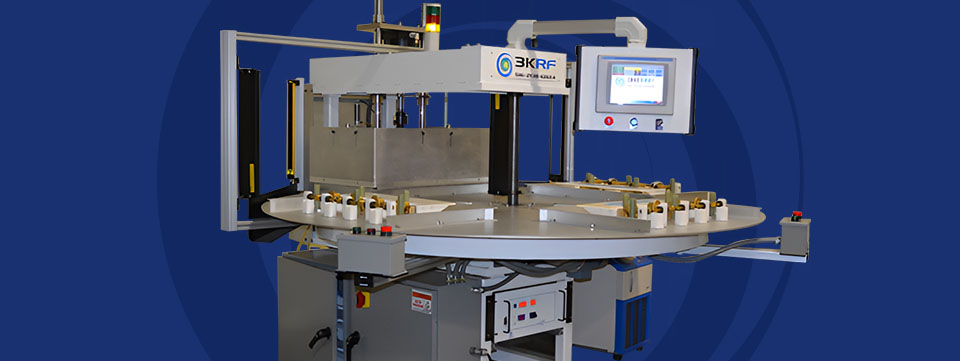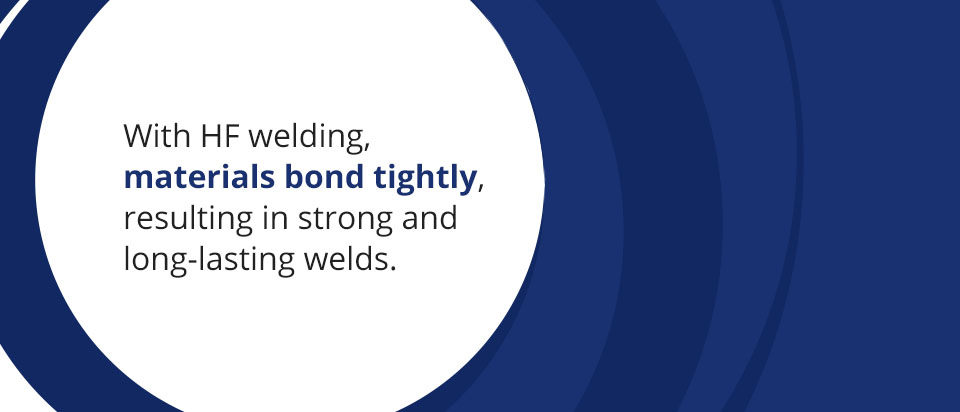High Frequency (HF) Welding Guide
High-frequency (HF) welding offers precision, speed and durable welds. The process fuses materials to create a seamless joint that can handle considerable strain and stress, making HF welding the preferred process for various applications.
Many industries benefit from high-frequency welded products, including the medical, automotive and recreational fields. Follow our guide to learn the mechanics, advantages and applications of high-frequency welding.
What Is HF Welding?
High-frequency welding — also called radio-frequency or RF welding — involves bonding materials using electromagnetic energy. It works by combining indirect pressure and heat to join molecules in the material through homogenous bonds. The molecules in the materials oscillate and release thermal energy, realigning themselves based on the energy field’s polarity.
As opposed to other welding methods, high-frequency welding produces heat from within the material. A durable weld forms after the material cools under pressure, with weld seams being as strong as surrounding materials, if not stronger.
The method is known for its speed and efficiency, operating at 27.12 megahertz to create strong airtight seals. It is often preferred for materials like plastics, fabrics and PVC when traditional welding techniques might not be as effective.
Due to the fast setup times and quick-change tooling, HF welding is perfect for manufacturing and higher-volume applications.
HF vs. RF Welding
You may see this process called high-frequency welding or radio-frequency welding. Since HF welding only uses high radio frequencies, HF and RF welding are essentially the same.
Components of High-Frequency Welding Machines
The main components of high-frequency welding machines include:
- High-frequency generator: The generator, or oscillator, creates the rapidly alternating electric fields required for the high-frequency welding process.
- Pneumatic press: The pneumatic press applies pressure throughout the welding process, often used due to its ease of control and reliability. This pressure is critical for creating a strong, durable weld.
- Electrode: The electrode transfers a high-frequency current from the generator to the material being welded. Often called a “bar,” this component precisely delivers the electromagnetic field to the seam area. It also applies pressure and can be tailored for specific tasks like cutting and embossing.
- Control system: Operators use the control system to adjust the field strength. This system manages parameters like power levels, welding and cooling time and pressure.
Advantages of High-Frequency Welding
High-frequency welding yields strong welds and consistent results, offering these advantages:
Fast and Accurate
The top advantage of high-frequency welding is its speed. Since this method heats materials from the inside out, the fusion process is extremely fast — typically ready within seconds. The precision of the electromagnetic energy offers exceptional accuracy, reducing the risk of errors or defects in the welding process.
Reliable and Consistent
HF welding uses reliable technology, ensuring consistent results with each weld. Focusing the heat on the welding target ensures the surrounding material does not superheat or burn to achieve the target temperature at the seam. The process leads to a high-quality product and repeatable outcomes.
Targeted Control
HF welding only generates heat when the field is energized. It offers greater control over the energy the material is exposed to throughout the welding process. The material can remain under pressure without adding heat. Welders can instantly heat, weld and cool the material under compression and increase weld strength.
Durable Welds
With HF welding, materials bond tightly, resulting in strong and long-lasting welds. The process quickly fuses materials while creating a seamless joint that can handle significant strain. This durability is especially important in applications like liquid tanks and inflatable products, where you must maintain an airtight barrier from air, gas and liquid.
Additionally, heat generated from HF welding remains localized, preventing heat degradation of materials adjacent to the weld and ensuring the product’s structural integrity.
Versatile
High-frequency welding can be easily adapted to various materials and thicknesses. The process offers versatility, welding multiple layers all at once. The method provides opportunities to create complex items and layered sections, increasing design potential, efficiency and adaptability for various applications.
You can also add decorative appearances, unique shapes or embossment with HF welding. These design enhancements offer more value to the finished product, making it an ideal manufacturing choice for various consumer goods.
Compatible High-Frequency Welding Materials
Materials suitable for high-frequency welding include:
- Polypropylene
- Polyurethane (PU)
- Barex
- Polyvinyl chloride (PVC)
- Polyethylene terephthalate (PET)
- Polyethylene terephthalate glycol (PETG)
- Pliofilm (rubber hydrochloride)
- Fabrics
- Tarpaulins
- Vinyl
HF welding is typically used on materials where the molecules allow themselves to vibrate due to the alternative electrical field, which is why PVC and PU are the most common thermoplastics used in the process.
The materials you use can be thick or thin, reinforced or coated or even colored or patterned. You might even use woven or knitted fabrics that have a layer of urethane on one side. For best results, you’ll need both sides of the product to be the same. Generally, you cannot weld two different types of material together, as the variation in their composition will prevent a bond from forming.
Uses for HF Welding
While HF welding is a strong fit for many industries, it’s particularly useful in medical applications ranging from blood separation systems and sealing blood bags to manufacturing hazardous waste containment systems. The technology is also helpful for inline production, including fabricating awnings, tarps and shades.
High-frequency welding technology benefits the following industries:
- Medical: HF welding technology can manufacture various products for the medical industry, including containment bags, pressure cuffs, mattress covers, oxygen bags, dust covers and bags for storing and keeping medical tools sterile.
- Recreational: Various companies in the recreational field can benefit from the versatility of RF welding, including both indoor and outdoor applications. Examples include vinyl curtains used in tennis courts at schools, gymnasiums and country club facilities.
- Automotive: The automotive industry uses high-frequency welding to manufacture various products, including car wash curtain walls, mechanic works stations and spray paint booths for workers. The seams can handle the daily rigors of these types of environments.
- Military: Military operations require products with strong and reliable seams. By using RF welding equipment, the military can benefit from durable products with the ability to resist tears, prevent the leakage of gas and fluids and handle extreme temperature changes.
Choosing High-Frequency Welding Equipment
When choosing high-frequency welding equipment for your projects, consider the following:
- Tooling compatibility: Choose a machine that is compatible with various tooling options and offers custom configurations. This compatibility offers flexibility in your designs and joints while offering quick tooling changeovers to minimize downtime.
- Control and monitoring features: Consider machines with advanced control and monitoring features for your welding projects. Machines constructed with high-quality parts and robust designs can help you create a superior product.
- Reliability and durability: Get your machine from a reputable manufacturer known for reliability and durability.
MarkPeri’s 3KRF technology offers all of these features and more, with greater flexibility and benefits than conventional tube-styling welding systems. Choosing our welding machines means reducing production times and power consumption while creating more precise welds. Custom configurations can help you tackle precision projects with accuracy and speed.
Partner With MarkPeri to Enhance Your Fabrication Processes
High-frequency welding offers precision, speed, and durable welds, and MarkPeri is your go-to source for top-of-the-line equipment. The HF welding process is known for its efficiency and strength, making it ideal for a variety of applications, including high-frequency fabric welding. Still unsure about what is high frequency welding? Our experts can guide you through the process and benefits, and we also cater to specialized applications like manufacturing high-frequency welded gaskets. High-frequency welding creates durable, consistent final products for a variety of industries, and MarkPeri’s 3KRF technology sets the standard for radio-frequency welding with considerably shorter production times and less power consumption to get precise, durable welds. Our innovative technology allows more flexibility and benefits than traditional systems. Invest in a high-quality high frequency welding machine from MarkPeri to enhance your fabrication processes and ensure consistent, reliable results. Discover the advanced capabilities of MarkPeri’s high-frequency welding equipment to enhance your fabrication processes. Contact us today to explore solutions tailored to your needs.



